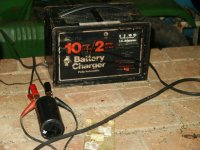I have used this technique extensively and would like to express my opinion on the safety aspects of free hydrogen from the electrolysis of water.
The link includes statements in two places about the danger of free hydrogen in enclosed spaces. There is no danger of hydrogen accumulating in an explosive concentration inside any enclosed space that has enough ventilation to support human life.
The problem with hydrogen is not that it concentrates. The problem is that it dissipates so readily that it is extremely difficult to collect and contain. Simply being air tight is not good enough to keep hydrogen contained. You are not courting death or explosion if you run the electrolysis bath inside your shop and allow the hydrogen (and oxygen) to dissipate into the atmosphere of your shop.
The process generates hydrogen so slowly and the hydrogen dissipates so rapidly that the risk of creating an explosive concentration is on about the same order as the risk of suffocating inside your house due to the buildup of carbon dioxide from your exhaled breath. It's a non-issue.
But I will emphasize the importance for getting the polarity correct. If you connect the positive lead to your workpiece, and leave it in the bath for an extended time, I can state from personal experience that you WILL destroy whatever it is you're trying to clean. That is not an opinion, it's a demonstrable fact. Note the red color of the positive lead on the battery charger. Red means danger. Hooking the RED lead to your workpiece is DANGEROUS to your workpiece's health.
As far as amperage/voltage is concerned, a 12 volt battery charger is sufficient. The greater the amperage the faster the process completes. If the amperage is so high that it generates enough heat to boil the water, then you probably ought to cut it back a little. It's doubtful that a regular homeowner type battery charger will output enough power to be of any concern. I'm tickled to death if my battery charger shows more than 3 or 4 amps during the process. If your charger needle pegs out, then you've probably got direct contact between the anode(s) and your workpiece.
For my next de-rusting task, I think I'll try using my DC stick welder as a power source just to see if I can get the amperage up enough to make the process go a little more quickly.


